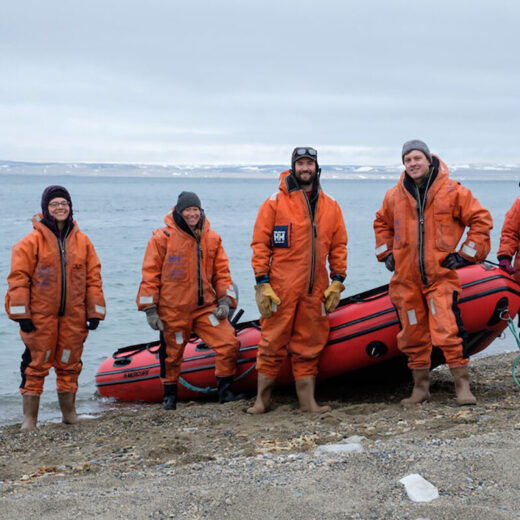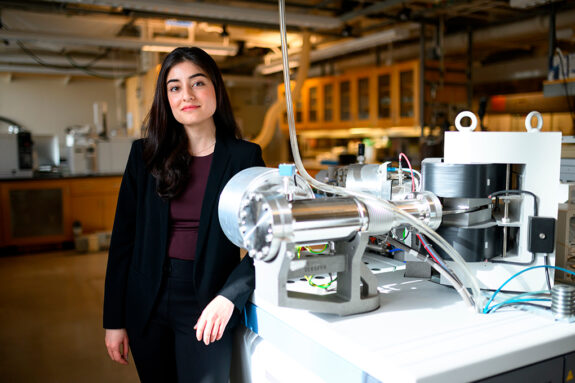Graduate Program

World-class training. Limitless possibilities.
Combining the momentum of MIT’s global research enterprise with the advantages of an accessible, collegial department, the Earth, Atmospheric and Planetary Sciences graduate program prepares students with the research and communications skills required to succeed as independent scientists.
Our program is ranked second in the country for its number of graduates who obtain tenure-track faculty positions in the Earth sciences.
EAPS graduate students in most cases pursue a doctoral degree. It is not necessary to earn a master’s degree before applying to the doctoral program.
Applicants interested in a master’s degree are advised to contact faculty prior to applying to ensure there is a faculty member who is potentially interested in acting as their advisor for a master’s degree.
Doctoral Program (PhD, ScD)
Students typically receive their degree in five years, with the first two years spent in coursework and research, culminating in a General Examination—which must be completed before the end of the second year.
Immediately after the General Examination, thesis research begins under the close supervision of one or more faculty members—chosen by the student—who are interested in and knowledgeable about the student’s area of research. Faculty supervisors may be members of EAPS or another MIT department. Each thesis is expected to meet high professional standards and make a significant original contribution to the student’s chosen field of science.
General Institute requirements for doctoral degrees can be found at catalog.mit.edu.
EAPS offers PhD, ScD degrees in the following areas:
| Atmospheric Chemistry |
| Atmospheric Science |
| Biological Oceanography1 |
| Chemical Oceanography1 |
| Climate Science |
| Computational Earth, Atmospheric and Planetary Sciences2 |
| Geochemistry |
| Geology |
| Geophysics |
| Marine Geology and Geophysics1 |
| Physical Oceanography1 |
| Planetary Sciences |
2 Offered as a joint degree with the Computational Science and Engineering Program — Applicants must apply through the CSE+ program for admission.
Master of Science Program (SM)
The master’s degree program—designed to be completed in two years—is suitable for motivated students with undergraduate degrees in geoscience, physics, chemistry, mathematics, or engineering. Students spend the first year taking classes and the second conducting research and thesis work. This program prepares students for scientific and management careers in the environmental, natural resources, and technical consulting fields.
General Institute requirements for master’s degrees can be found at catalog.mit.edu.
For the degree of Master of Science, the student must have satisfactorily completed
- at least 66 units of graduate subject credit
- a thesis approved by the department in which they are enrolled.
If 34 units and the thesis are in a single approved program, as determined by the EAPS Committee on Education Programs (CEP), the degree will be recommended with specification (e.g. Climate Science, Atmospheric Science). Otherwise, the degree will be recommended without specification (SM: Earth and Planetary Sciences).
The same high standard of academic performance in a program approved by a departmental committee on graduate students is required for degrees with or without specification.
EAPS offers SM degrees in the following areas:
| Atmospheric Science |
| Chemical Oceanography3 |
| Climate Science |
| Earth and Planetary Sciences |
| Marine Geology and Geophysics3 |
| Physical Oceanography3 |
Fifth-Year Master of Science Program (SM): Continuation of an MIT Undergraduate Degree
Current MIT undergraduate students with strong academic records from the departments of EAPS, chemistry, physics, mathematics, CEE, EECS, chemical engineering and others may complete a master of science in Earth and Planetary Sciences, Atmospheric Sciences, or Ocean Sciences, with just one year of additional study. The degree requirements of the 5th year master of science are the same as those for the traditional masters degree above, but they are condensed into a single year. Students may begin to take graduate level courses while pursuing their undergraduate degree and petition to use them towards their 5th-year masters. Only courses that are not being used toward undergraduate requirements can be applied to the 5th-year master of science degree.
You’ll find EAPS student handbooks, academic forms, and thesis guidelines, alongside lots of MIT links to help you build your career and support work-life balance.
We’re here to support every aspect of EAPS academic programming and are an important part of our students’ support network, helping to connect you with resources and opportunities.
Prospective students, if you have a question about academic life at MIT, or want to arrange a visit, please don’t hesitate to reach out!

Ann Greaney-Williams
Assistant Director of Academic Programs
Room: 54-910
Phone: 617-253-3380
Email: agreaney@mit.edu
On Campus Schedule: Monday, Wednesday, Thursday
Remote Schedule: Tuesday, Friday
Co-chair of the EAPS Committee on the Education Program and responsible for administrating Course 12 undergraduate and graduate programming. Advises students regarding degree requirements, career options, funding, policies and procedures, and Institute resources for student support.

Alana Snelson
Senior Academic Program Assistant
Room: 54-912
Phone: 617-253-3381
Email: asnelson@mit.edu
On Campus Schedule: Monday-Friday
Provides administrative support for the EAPS Education Office, including room scheduling, classrooms and supplies, reimbursements, Canvas sites, student appointments, and various forms, including grading and evaluations, registration, and thesis submissions.
Research Areas + Academic Concentrations
Through consultation with a department committee and a personal faculty advisor with mutual research interests, each student develops a specialized program of study and research tailored to their background, needs, and goals.
We invite you to explore our research pages and our faculty bios to discover where your interests might intersect with current faculty projects.
While the research in our department is inherently interdisciplinary, students are admitted to one of four academic program concentration areas:
Collaboration is at the core of our community.
In EAPS, students and faculty work side by side to answer profound questions about the natural world—and to shape the department of tomorrow. Our interdisciplinary research and informal atmosphere offer students opportunities for networking and scientific collaboration unmatched by any other program. In addition to benefitting from a robust schedule of guest lectures on topics in current research, EAPS students also serve on departmental committees and lead community groups.
Explore Our Community

Looking for the MIT-WHOI Joint Program?
The MIT-Woods Hole Oceanographic Institution Joint Program in Oceanography/Applied Ocean Science and Engineering is a five-year doctoral degree program.
Combining the strengths of both MIT and WHOI, the program encompasses one of the largest oceanographic research enterprises in the world. Joint Program students have unparalleled access to scientists, classes, programs, and resources at both institutions. In addition, WHOI supports a world-class research fleet, providing students with ample opportunities to conduct their work at sea.
EAPS-affiliated students in the MIT-WHOI Joint Program pursue degrees in:



